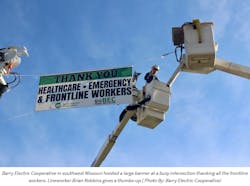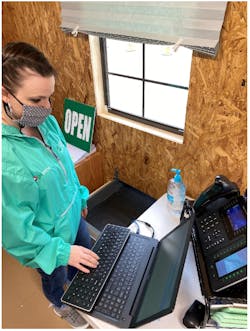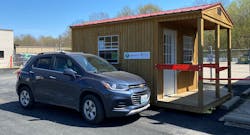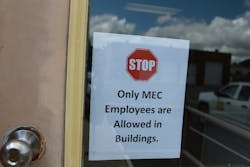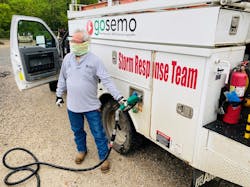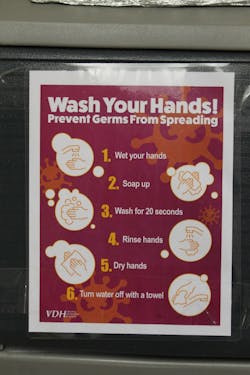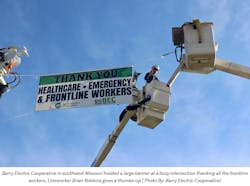Co-ops Moved Swiftly during Pandemic
Senior electric co-op leaders spoke with NRECA and T&D World about the COVID-19 pandemic. The first part of this article focuses on how co-ops moved swiftly to protect the safety and health of their employees and the public. In the concluding part, the co-op leaders discuss the hard issues going forward.
Slevin, president of the Utility Workers Union of America, just called for a federal emergency standard to protect workers during the pandemic and the American Federation of Labor and Congress of Industrial Organizations (AFL-CIO) to take legal action to force the Occupational Safety and Health Administration to issue an emergency temporary standard for infectious diseases.
Part 1: What Has It Been Like for Electric Co-op Utilities?
Immediate actions taken
Tony Campbell, CEO, East Kentucky Power Cooperative (EKPC)
EKPC set up a page on the co-op's employee intranet with all kinds of resources to educate workers about everything from hygiene to making face masks to accessing mental health resources through our employee assistance program.
John Lee, CEO, Mecklenburg Electric Cooperative (MEC)
All MEC employees are essential workers and are expected to comply with all our safety measures. Anyone experiencing symptoms, or living with someone experiencing symptoms, cannot come to work until tested or until they have met CDC guidelines for returning to work.
We are also keeping a close eye on all our employees and their "state of mind," recognizing that times like these affects everyone differently. We are prepared to respond and offer assistance. At MEC, we constantly reiterate to our employees that we'll get through this together and that we will do everything possible to keep our organizations safe and healthy.
MEC is introducing work flexibility measures, working with employees with no childcare options or family members unable to assist themselves. We have also reminded employees about the availability of employee assistance services for anyone struggling with the pandemic.
Sean Vanslyke, CEO, SEMO Electric Cooperative (SEMO)
We are not letting the pandemic get in the way of SEMO's progress. We have stay-at-home orders in effect. That has not prevented us from making organizational changes. We are promoting some employees and hiring new employees. At first, some staff thought this might not be the right time to promote a new supervisor, but as I see it, learning how to do their new jobs in this environment is great training.
To protect workers and the public, we built drive-up facilities. Within 48 hours of making the decision to transition to drive-up service, our team had the buildings up and provided with electricity and internet access. We had also informed our members of the change.
Social distancing issues
Sean Vanslyke, CEO, SEMO
Social distancing among field workers is challenging. Maintaining distance may not be possible when two people are working together from buckets in the air. Framing and setting a pole is at least a two-person job. Think about the closeness these jobs require. How can these workers perform them safely? The same goes for replacing a transformer. Hoisting a 10,000- to 20,000-lb transformer requires teamwork.
The reality is that some speed in the recovery process is going to have to be sacrificed. The workers will have to take time to follow the new safety procedures.
Tony Campbell, CEO, EKPC
The biggest source of exposure for us is contractors. EKPC has protocol in place for employees who come in contact with a confirmed or suspected case of the coronavirus.
We recognized immediately the potential risk from and to contractors because EKPC has a critical construction project ongoing at one of our plants. At that site, we've implemented strict measures. We're keeping the contractors segregated from plant employees, unless contact is absolutely necessary.
John Lee, CEO, MEC
MEC is avoiding contact with the public. We prohibit anyone from entering our buildings except the specific employees whose offices are located there. We set up temporary mailboxes outside for members to transact business and have encouraged the membership to use our 24-hour kiosks, and the other electronic communications and bill pay options we offer. We have been emphatic with the public to avoid interaction with our crews in the field, encouraging them to call the office if they need to communicate with the crew.
Doubling down on safety during the pandemic
John Lee, CEO, MEC
We are redoubling our efforts to make sure line crews stay laser focused on their work and making certain they are keeping safely first, despite the many distractions. Tailgate meetings (held outdoors and with 6 ft between participants) have never been more important. I anticipate that our observers will be more necessary than ever to make certain everyone is focused on the job and working safely.
When MEC staff transitioned to alternating home/office shifts, all employees signed an agreement pledging that they would work diligently from home. That agreement included emphasis on safety while working from home as well.
On a weekly conference call with all employees and at every tailgate session, we remind our employees that while we recognize these are stressful and troubling times, they cannot allow themselves to become distracted. Now, more than ever, they must focus squarely on the task at hand. We are aggressive in stressing to employees that if they are distracted, they should take a step back, clear their mind, refocus on the job, and only then proceed with the work.
Tony Campbell, CEO, EKPC
We continue with safety messaging such as our daily safety email, starting every meeting with a safety moment and posting safety messages on our company intranet. I've tried to remind employees that while we're all thinking about preventing the spread of the coronavirus, we still have to be diligent about everyday safety — things like paying attention when we drive or following safety procedures when performing tasks.
Co-ops were ready for this
Sean Vanslyke, CEO, SEMO
Looking back, all the disasters I have experienced in my career — from ice storms to 9/11 — were training me for this event. And now I have an opportunity to pass that learning on to younger members of our staff.
COVID-19 is in Scott County and we know there's community spread. While we have put social distancing policies in place, we are also now looking toward the future and trying to understand what we can do to prevent a second wave. How are we going to adapt to the new world?
Things are not ever going to be exactly the same because some of the adaptations we made are improvements.
SEMO is not unique. It's incredible what the co-ops are doing — we are all pulling the same rope the same way. We're all getting better and we're all learning. The pandemic is teaching us how important it is to be connected.
Dale Kishbaugh, director of safety and loss, Colorado Rural Electric Association (CREA)
In Colorado, we have some of the best managers you will ever meet. Together, they are discussing the challenges and the solutions, weighing all the pros and cons. At the same time, the managers are making their own decisions. Every one of them has a different game plan, but their top priority is always the safety of the crews.
John Lee, CEO, MEC
I want to note that everything we put into place both at MEC and our broadband service has been influenced by the confidence I have that our employees are responsible and disciplined, and will always do the right thing. Having excellent employees like ours makes dealing with a catastrophe like this less daunting and makes our safety measures exponentially more effective.
I am very proud of the way our employees have responded to this public health crisis — but they always step up in difficult times.
Part 2: What Are the Hard Issues Going Forward?
Better communicators
Dale Kishbaugh, director of safety and loss, CREA
CREA is coordinating the state's pandemic response with its 22 distribution co-op members. We have replaced in-person meetings with conference calls and emails, and the result is a lot more communication. Instead of in-person quarterly safety meetings that rotate among distribution co-op offices, we now have weekly calls with managers and bi-weekly calls with operations managers, safety managers, and the statewide disaster committee. We will soon be switching to video conferencing. Co-op staff are really opening up on these calls, sharing approaches and thinking through the challenges.
Transitioning from in-person meetings to conference calls requires us to be better communicators. We have to be very clear in our emails. If you're meeting in person at a facility, it's easy just to point to something and then ask, "Do you see what I'm saying?" Now we have to rely on words, though we're starting to use more videos. Describing everything with words is more difficult. We have to be very clear and precise in our emails. But I think this is a positive development.
Here at the Colorado statewide, our operations staff has been working much more closely with the communications and education department. For example, we are working with communications to find the best platforms for sharing videos.
Sean Vanslyke, CEO, SEMO
SEMO has been conducting safety meetings on Zoom. We are trying to make them more fun. Meeting remotely makes it easier to get everyone to the meeting, which also means everybody is hearing the same thing. That's an advantage when it comes to safety and health information, and I think this will become part of the new normal.
We are teaching our team — from senior leaders to frontline workers — how to be comfortable on Zoom. Every member of the staff, at some point, will have the opportunity to present his or her team's update on Zoom.
Staying safe during storm recovery
John Lee, CEO, MEC
We have been fortunate (knock on wood) and have had no major storms since the pandemic began, but if we do, we believe the measures we have in place now would provide the protection needed for our crews.
Already, line crew members are never in the small cab of a vehicle together. That risk was our greatest concern for our crews and so we assigned separate vehicles to workers early on. We have provided our line crew members with sanitizers, disposable rubber gloves, and masks for their use, if needed. Most importantly, we provide them with valuable information they can use to protect themselves and those around them.
Tony Campbell, CEO, EKPC
EKPC has provided strict guidance about preventing contact between crews, whether those are EKPC crews or crews from contractors or other utilities. Within a crew, occasionally, close contact is necessary to perform a task, particularly if two workers are going to be in a bucket together. In those situations, workers wear masks and take steps to minimize contact — for example, they can't use each other's tools.
Dale Kishbaugh, director of safety and loss, CREA
Occupational and Safety Hazards Administration (OSHA) and Department of Homeland Security (DHS) have been great partners in all of this; they are listening to us. I have had five or six conversations with them. We all want to be on the same page. We all need to be in agreement. OSHA has been very open to discussing our concerns, especially the concern that some safety protocols can become hazardous when applied to utility operations.
One concern is the requirement to wear face masks. Firstly, non-surgical face masks are not fire-retardant. We are also concerned that masks could create a distraction. We don't want line workers fiddling with the mask when they're working. Also, the masks might muffle workers as they're trying to communicate with each other.
We need to have these conversations now and explain to officials at every level of government the reasoning behind our actions and the protocols we are following. We also need to communicate what we are doing and why to the public.
Sean Vanslyke, CEO, SEMO
We are all wearing masks in co-op buildings. Oftentimes, during a storm people will congregate in the dispatch area, which is the war room. Now, no more than four people can be in the dispatch area. So, we have to rotate people in and out and conduct more communication by text or phone.
Preventing disease transmission during mutual assistance events
John Lee, CEO, MEC
If an event requires us to provide mutual assistance to other utilities or vice versa, MEC expects that employees will adhere closely to the COVID-19 safety measures we have in place.
We will ratchet up education and awareness efforts during those high pressure and stressful major outage scenarios. We will isolate visiting crews from our workers, recognizing that every cooperative is likely handling this pandemic differently, at the same time ensuring they understand our procedures and safety measures. We will provide visiting crews with the same amenities we provide our own, including a capable and knowledgeable guide while working on our system. We'd also insist that they respect distancing guidelines while working on our systems with both members and employees.
While we have had no requests for mutual aid, we certainly would not be apprehensive about offering aid to nearby cooperatives. I believe our staff has done an incredible job of educating and communicating with employees about the precautions they must take.
Additionally, we would send our crews to assist others with the mutual understanding that should MEC crews be uncomfortable with any measures taken or not taken by the host utility to address the COVID-19 pandemic, they could return home immediately.
Return to the new normal
Tony Campbell, CEO, EKPC
The silver lining of this challenging situation has been the opportunity to learn and improve. We have exercised our pandemic plan and learned where it works well and where we need to improve. As a result, I think we will continue with intensive cleaning of offices and facilities. We also will continue to keep on PPE on hand for our employees and in quantities large enough to carry us through a similar event.
John Lee, CEO, MEC
Like everyone, we are eager for the return to normalcy. Most of our precautions are "cut and dried," so there is little or no opportunity to slowly unwind within phases of "re-entry." I expect we will be eliminating one measure at a time as our state mandates and the pandemic dictates.
As we have done from the beginning, we'll defer to credible sources for information to determine how quickly we unwind the measures we have put into place.
I will be consulting with my senior management team and our employees, as we move cautiously back to normal operations. We will also be prepared to change course aggressively, if necessary.
Multiple layers of guidance
Dale Kishbaugh, director of safety and loss, CREA
As a statewide organization, one big challenge that we all face is knowing and following the rules in each of the counties we visit. Staying in touch with the cooperatives and following their guidelines is a must.
As federal, state, and local agencies are putting out guidance for reopening, we are hearing a lot of different messages. While the state has issued its own guidance for reopening, localities like Denver have their own protocols. We want to follow the safety protocols, but there's not one single set of guidelines.
Tony Campbell, CEO, EKPC
EKPC is following the guidance of state and federal health officials, who are developing step-by-step plans with measures to indicate whether conditions are improving or worsening. We are like a family, so the health and safety of our employees always comes first. That is particularly true during this pandemic. Heath officials will determine whether we continue to open up, or pull back and reinstate protective measures.
John Lee, CEO, MEC
I am currently the chairman of the board of directors of our local hospital and, accordingly, I'm privy to almost daily updates and information from healthcare professionals, information untainted by any other agendas. That is the intelligence we have used to determine our course of action and measures enacted.
About the Author
Tony Campbell
Tony Campbell is CEO at East Kentucky Power Cooperative (EKPC) based in Winchester, Kentucky. The cooperative distributes, generates, and transmits electricity to 16 local distribution cooperatives, which in turn provide electricity to customers in 87 counties in eastern Kentucky.
Sean Vanslyke
Sean Vanslyke is CEO and general manager at SEMO Electric Cooperative based in Sikeston, Missouri. The cooperative generates, transmits, and distributes electric energy to agricultural, industrial, and residential customers in the state of Missouri. SEMO also provides high-speed internet service through GoSEMO Fiber.
John Lee
John Lee is CEO at Mecklenburg Electric Cooperative (MEC) located in Chase City, Virginia. The energy provider serves customers in portions of counties in Virginia and North Carolina. MEC also provides high-speed internet service through its subsidiary, EMPOWER Broadband.
Dale Kishbaugh
Dale Kishbaugh is director of safety and loss control at Colorado Rural Electric Association (CREA), a statewide association serving Colorado's 22 electric cooperatives that distribute electricity as well as Tri-State Generation and Transmission Association, which generates the electricity for 17 of those co-ops.
